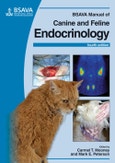Since publication of the third edition in 2004 there have been important advances. Several endocrine disorders, such as feline acromegaly and hyperaldosteronism, have risen in importance. The use of diet and novel insulins in diabetic cats, and new drugs such as trilostane and methimazole, which were briefly mentioned in previous editions are now considered routine. In addition, the genetic risks associated with many disorders have been elucidated.
- A new chapter presents the principles of interpreting endocrine test results and discusses how test performance is assessed in relation to diagnostic confidence.
- The central section on glands and their diseases is presented in a standard format -- detailing physiology, aetiology, clinical features, diagnosis and treatment - to aid information retrieval.
- The final section has been rewritten to focus on solving clinical and clinicopathological abnormalities with an endocrine dimension.
Table of Contents
IntroductionHormone assays and collection of samples
Principles of interpreting endocrine test results
The pituitary gland
Disorders of vasopressin production
Pituitary dwarfism
Acromegaly
The parathyroid gland
Hyperparathyroidism
Hypoparathyroidism
The thyroid gland: Canine hypothyroidism
Canine hyperthyroidism
Feline hyperthyroidism
Feline hypothyroidism
The pancreas
Canine diabetes mellitus
Feline diabetes mellitus
Insulinoma and other gastrointestinal tract tumours
The adrenal gland
Canine hypoadrenocorticism
Canine hyperadrenocorticism
Feline hyperadrenocorticism
Feline hypoadrenocorticism
Feline hyperaldosteronism
Presenting complaints and their investigation
Investigation of polyuria and polydipsia
Investigation of hypercalcaemia and hypocalcaemia
Investigation of unstable canine diabetes mellitus
Investigation of unstable feline diabetes mellitus
Ketoacidosis; Investigation of hypoglycaemia
Investigation of symmetrical








